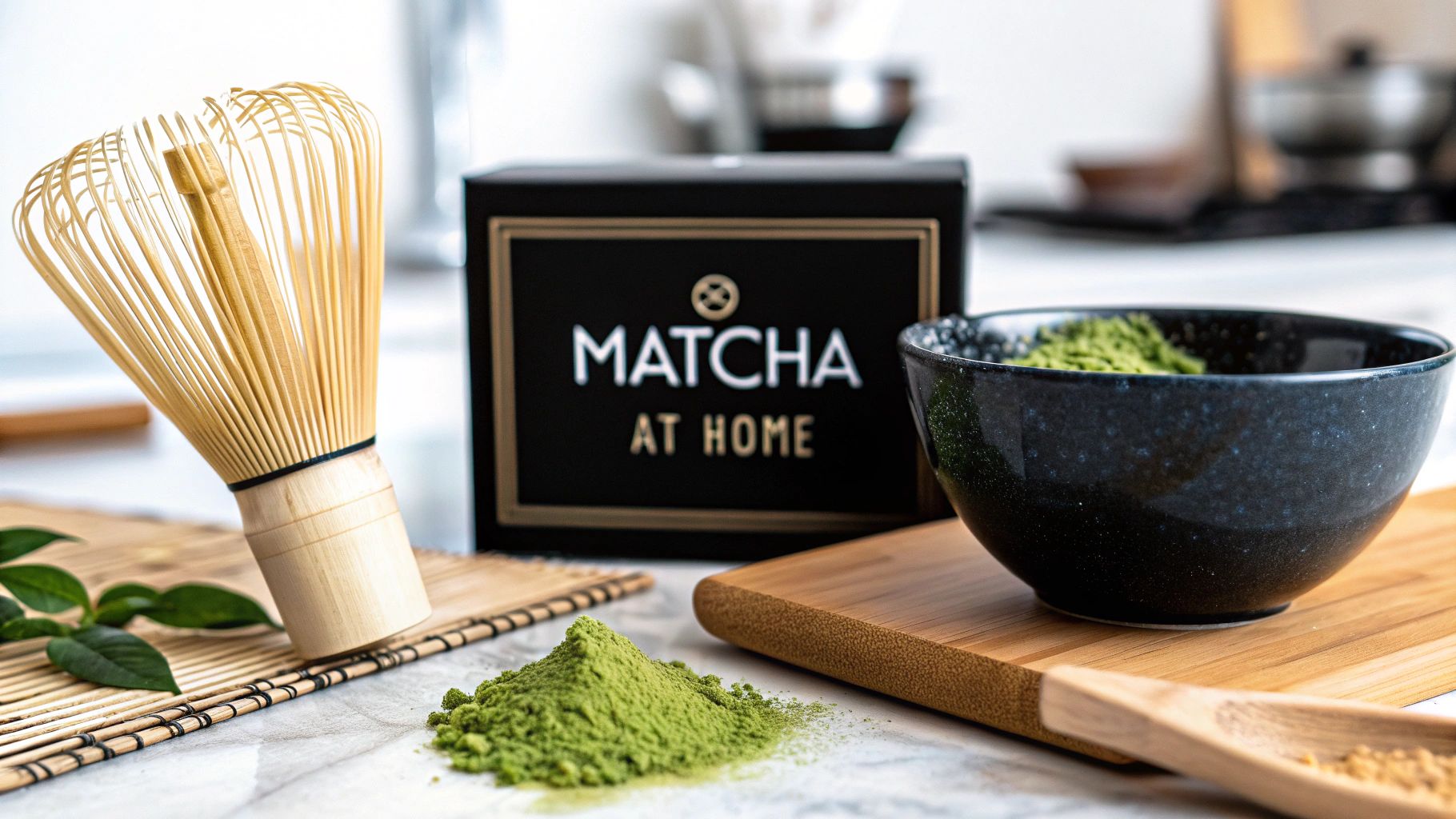Making matcha at home is your ticket to a perfect cup, every single time. It's about taking the reins—controlling the flavour, strength, and quality—and turning a simple drink into a mindful daily ritual that fuels your wellness goals, all without the café queues.
Why Your Best Matcha Is Made at Home
Let's be honest, the matcha from your local coffee shop can be a bit of a gamble—often overpriced, sometimes inconsistent. The most rewarding matcha experience actually starts in your own kitchen, where you're in charge of your daily wellness ritual.
Preparing matcha yourself is more than just whisking some green powder into water. It's a chance to connect with what you're drinking, making sure every single bowl is exactly how you love it.
You get complete control over the final result. You choose the quality of the matcha, get the water temperature just right, and find that perfect balance of flavour. Whether you're a traditionalist who loves it whisked with water or you prefer a creamy latte, you can tailor it perfectly to your taste.
The Power of a Personalised Ritual
Crafting your own matcha lets you tap into its unique benefits on your own terms. That special combination of L-theanine and caffeine is what creates a state of calm alertness, giving you sustained energy without the jitters you might get from coffee.
This makes it a fantastic drink to start your day with focus or as a gentle mid-afternoon pick-me-up. For a deeper dive into the science behind this, you can learn more about matcha for energy in our detailed guide.
Better yet, you can elevate this daily practice by choosing a blend that aligns with your specific wellness goals.
- For pure focus: A ceremonial grade like Amatsu's Pure Matcha is perfect. It delivers that classic, vibrant taste you want for a traditional preparation.
- For skin support: A blend like Radiance Matcha, infused with marine collagen, turns your daily cup into a beauty-boosting habit.
- For enhanced energy: A functional blend like Strength Matcha can supercharge your pre-workout routine or help you power through a busy afternoon.
- For mental clarity: Our Shrooms Matcha combines premium matcha with adaptogenic mushrooms to help you find your flow state.
Joining a Growing Global Trend
This shift towards making matcha at home isn't just a niche hobby; it's part of a much larger movement. The global matcha market is projected to shoot past £6 billion by 2032, fuelled by a growing desire for natural wellness products.
Here in the UK, people are increasingly looking for natural energy alternatives, and matcha is a clear favourite. With its incredibly high antioxidant levels—up to 137 times more than regular green tea—it's easy to see why.
This trend is backed by data showing that increased home preparation is a major driver of the UK's matcha market growth. People are embracing both its health benefits and its amazing versatility in the kitchen.
Gathering Your Essential Matcha Toolkit
To get that perfect bowl of matcha at home, having the right gear makes all the difference. While the traditional tools might look a bit formal, they're actually brilliantly simple and designed for one thing: making a flawless, frothy cup of tea. Investing in a few key pieces will completely transform your matcha game.
The Tools of the Trade
At the heart of any matcha setup is the bamboo whisk, or chasen. Its delicate, flexible tines are expertly crafted to whip air into the tea and dissolve the powder completely. This is what creates that signature creamy foam you just can't get with a regular metal whisk. Using a chasen turns making tea from a simple task into a mindful ritual.
Then you have the matcha bowl, known as a chawan. Its wide, flat bottom isn't just for show; it gives the whisk plenty of room to work its magic, making it so much easier to build up a rich froth.
Finally, the bamboo scoop, or chashaku, is carved to measure the ideal amount of matcha powder for a single serving. It brings a welcome consistency to every bowl you prepare.
Having the traditional set isn't just about honouring the Japanese tea ceremony; it's genuinely about getting the best results. Each tool has a specific job to do in getting the flavour and texture just right.
- The Chasen (Bamboo Whisk): This is your key to a clump-free, airy texture. Its 100-plus prongs are designed to suspend the fine powder perfectly in the water.
- The Chawan (Matcha Bowl): The wide base and high walls are practical, preventing splashes and allowing for the vigorous 'W' or 'M' whisking motion needed for a great foam.
- The Chashaku (Bamboo Scoop): This little scoop measures about one gram of matcha, so you can stop guessing. Two scoops are usually perfect for a standard serving.
If you're just starting and want to dive deeper, our guide on choosing a ceremonial matcha set has some great tips on what to look for in your first kit.
You might be surprised to see how matcha stacks up against other daily drinks.
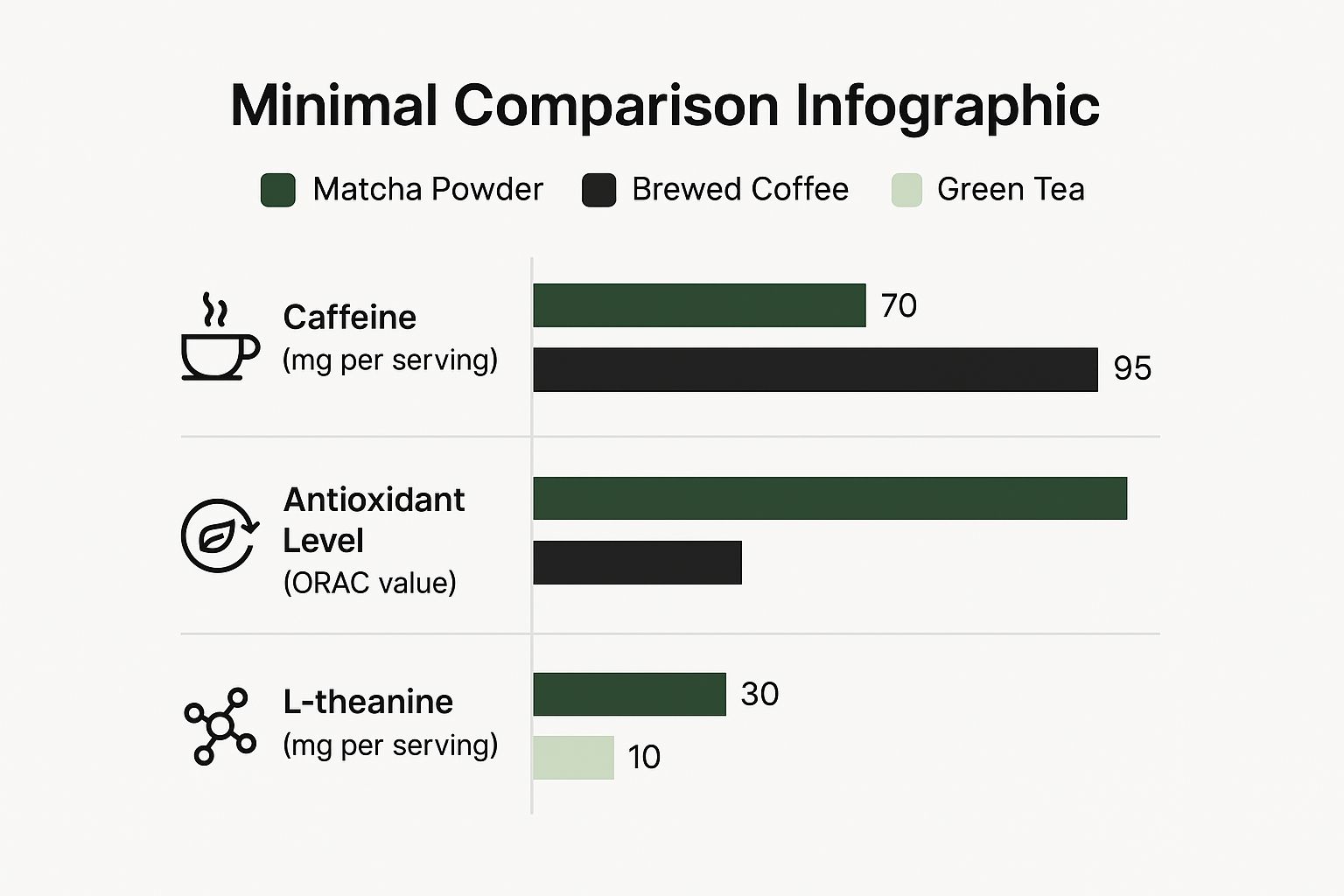
While coffee often wins on pure caffeine content, matcha brings a powerful dose of L-theanine into the mix, which is known for creating that feeling of calm, focused energy.
Your Matcha Toolkit Essentials vs Alternatives
Don't feel like you need to rush out and buy everything at once. While the traditional tools are fantastic, you can get started with things you probably already have in your kitchen. Here’s a quick comparison to help you figure out what you need.
| Tool | Traditional Option | Why It's Used | Everyday Alternative |
|---|---|---|---|
| Whisk | Chasen (Bamboo Whisk) | The 100+ fine tines perfectly aerate the tea and break up clumps, creating a rich, smooth foam. | Electric Milk Frother: A fantastic, quick alternative that whips up a decent foam. |
| Bowl | Chawan (Matcha Bowl) | Its wide, flat bottom provides the ideal space for whisking without splashing. | A Small Cereal Bowl or a Wide Mug: Look for something with a flat bottom and enough room to whisk. |
| Scoop | Chashaku (Bamboo Scoop) | Measures a consistent portion (~1 gram) of matcha powder for repeatable results. | 1/2 Teaspoon: This is a pretty close measurement for one serving of matcha. |
| Sifter | Fine-mesh Sieve (Furui) | Removes any clumps from the matcha powder, ensuring an ultra-smooth, silky texture. | Any Small Tea Strainer or Sieve: Works perfectly for getting rid of pesky clumps. |
The most important thing is to start somewhere. You can always build up your collection of tools as your love for matcha grows. The experience is what counts.
Mastering the Art of Whisking Matcha
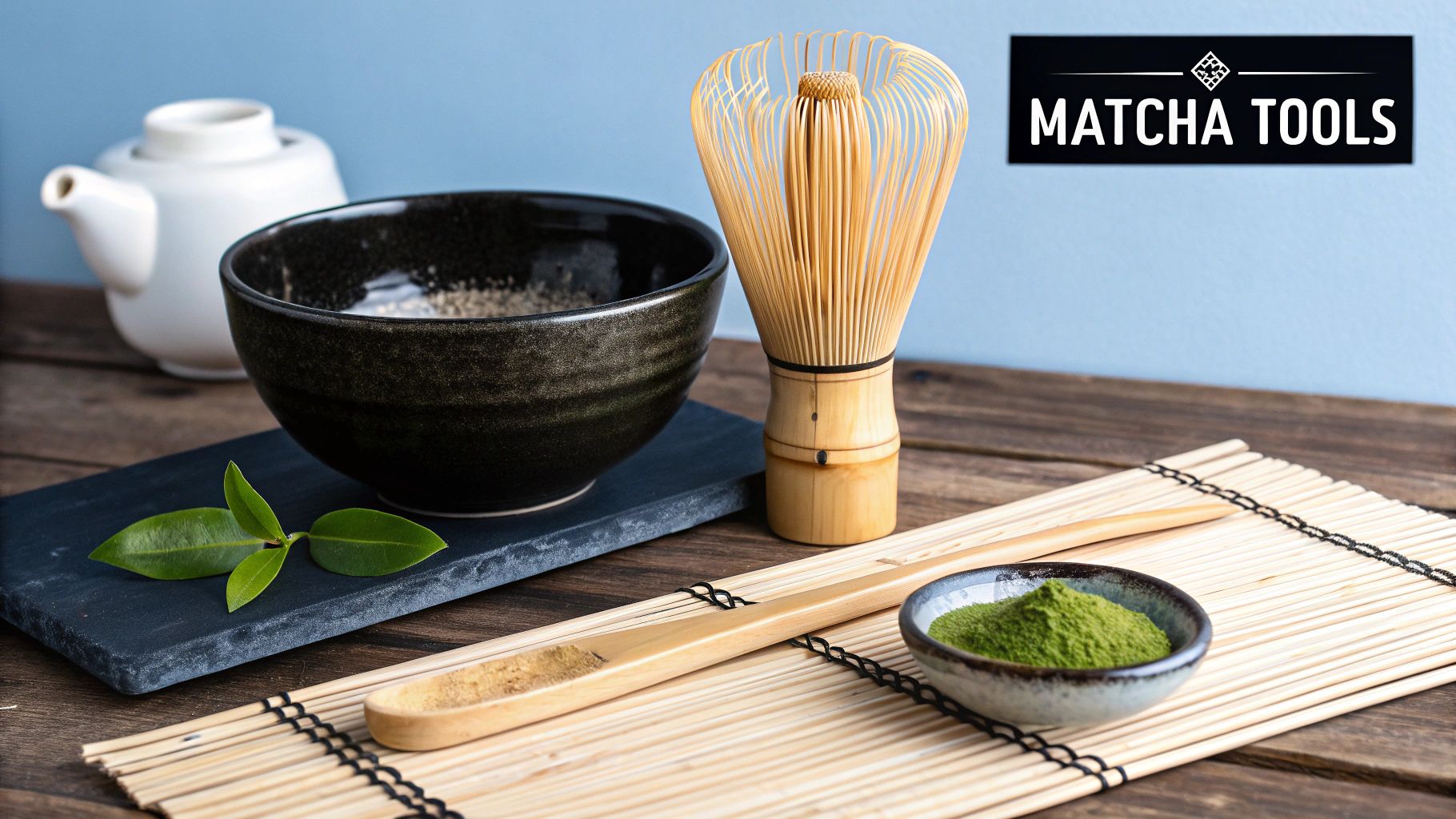
The real magic of transforming matcha from a fine green powder into a vibrant, bitter-free drink happens in the whisking. This is where you create that creamy, frothy texture that makes a bowl of matcha so special. It’s a hands-on process that feels a bit like a ritual, and it’s completely worth the effort.
Before you even pick up your whisk, there’s one step you absolutely cannot skip: sifting. Matcha powder is incredibly fine, which means it loves to form little clumps. Pushing it through a small, fine-mesh sieve is the only way to guarantee a silky-smooth brew.
Honestly, this tiny bit of prep work is a game-changer. It prevents those gritty, undissolved lumps and helps the tea blend beautifully with the water.
Getting the Temperature and Technique Right
Next up is the water. Using boiling water is a common mistake that will scorch the delicate tea, leaving you with a harsh, bitter flavour. You’re aiming for hot, but not boiling. The sweet spot is around 80°C (176°F).
A temperature-controlled kettle makes this easy, but if you don't have one, just let your boiled kettle cool for a few minutes before pouring.
Now for the main event. Add your sifted matcha to the bowl, pour in your perfectly heated water, and get your bamboo whisk (chasen) ready.
Forget stirring in circles as you would with coffee. The secret is a rapid, zig-zag motion. Imagine you’re drawing a 'W' or an 'M' back and forth across the bowl. This movement is what whips air into the mixture, creating that signature layer of delicate foam.
Keep your wrist loose—all the action should come from there, not your whole arm. And don’t grind the whisk into the bottom of the bowl; you want the tines to almost dance across the surface. After about 15-20 seconds of brisk whisking, you’ll see a beautiful, uniform foam appear. If you want a more detailed breakdown, our guide on how to whisk matcha perfectly has you covered.
Understanding Usucha and Koicha
Once you get the hang of the basics, you can start experimenting with different styles of matcha. The two traditional preparations you'll hear about most are Usucha and Koicha.
-
Usucha (Thin Tea): This is the light, frothy, everyday style you’re probably used to. It uses more water and less matcha (think 2 scoops to 70ml of water) and is whisked vigorously to create that lovely foam. It’s the perfect daily ritual and works brilliantly with a high-quality ceremonial grade like Amatsu's Pure Matcha.
-
Koicha (Thick Tea): This is a completely different beast. It's a much thicker, more intense preparation that's typically saved for special tea ceremonies and requires the very highest grade of matcha. You use double the matcha and half the water, creating a consistency almost like melted chocolate. Instead of whisking, it’s more of a slow, kneading motion to blend everything together.
The rise of brewing at home is part of a much bigger trend here in the UK. We're seeing a huge growth in people enjoying matcha at home, with data showing that the classic grade, ideal for daily Usucha, held the largest global market share at 57.1% in 2023. This tells us that people across the UK are embracing accessible, high-quality matcha for their daily routines, shifting it from a niche café treat to a wellness staple in their own kitchens.
Creative Matcha Recipes Beyond the Bowl
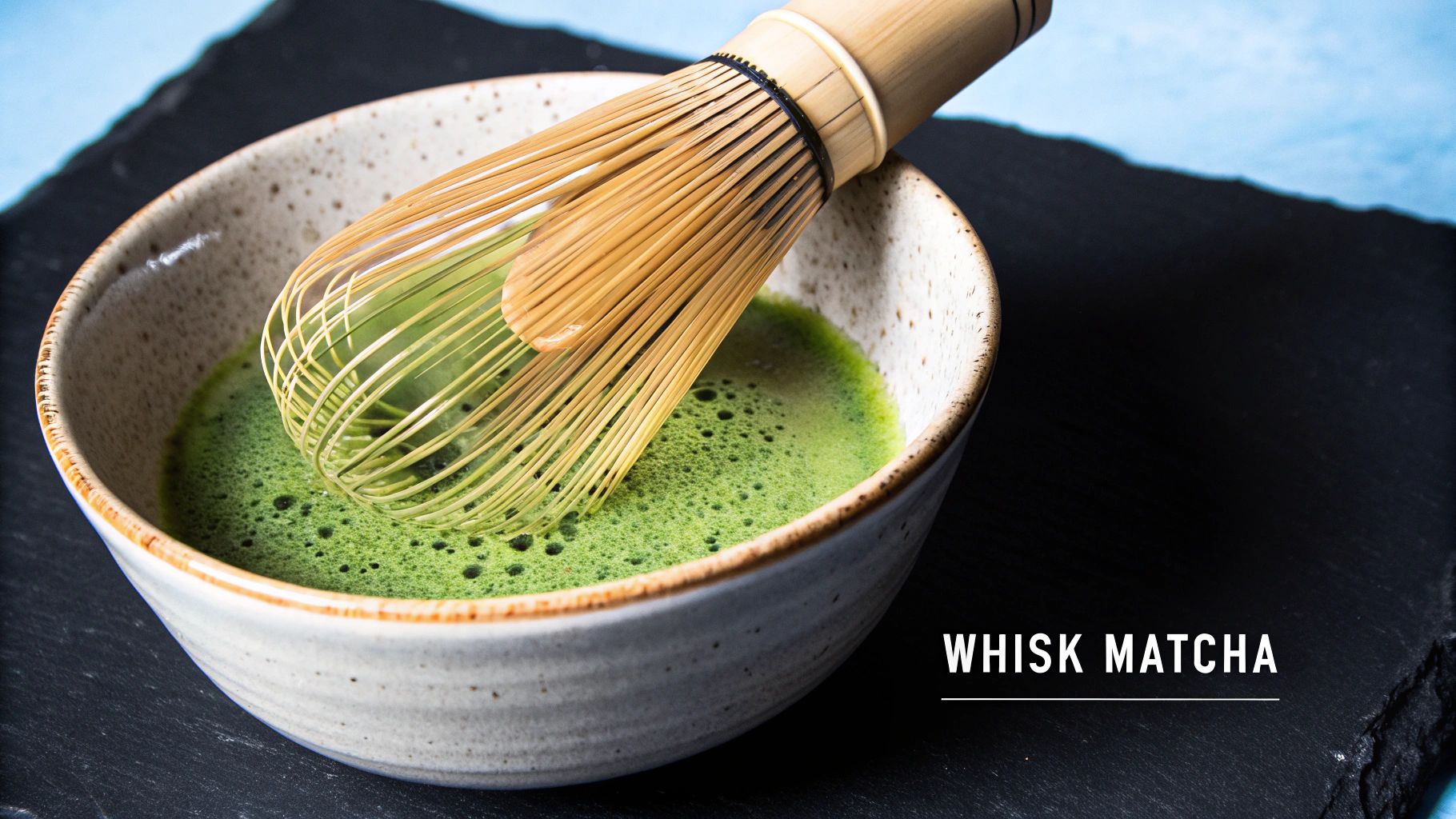
Once you’ve got the hang of whisking a traditional bowl of matcha, a whole new world of culinary creations opens up. That unique, earthy flavour isn’t just for your morning ritual; it’s an incredibly versatile ingredient that can transform everything from lattes to post-workout smoothies. It’s time to take your matcha at home journey beyond the chawan.
The most natural next step for many is the matcha latte. It's a comforting, creamy drink that feels like a treat but is brimming with goodness. The best part? Making one at home is far easier than you might think and gives you complete control over the sweetness and flavour profile.
To make a flawless hot matcha latte, you’ll start by preparing a concentrated matcha "shot". Just whisk one teaspoon of matcha with about 60ml of hot (never boiling) water until it's perfectly smooth and frothy—just as you would for a traditional bowl. Then, gently pour in your favourite steamed milk and add a touch of sweetener if that's your thing.
Choosing Your Perfect Milk Pairing
The milk you choose can completely change the character of your latte. Each type brings a different texture and flavour, so it’s well worth experimenting to discover what you love most.
- Oat Milk: This is a firm favourite for a reason. Its inherent creaminess and subtle sweetness complement matcha’s grassy notes beautifully, without stealing the spotlight.
- Almond Milk: A lighter choice with a delicate, nutty taste that really lets the matcha shine. It’s perfect if you prefer a less rich, more tea-forward drink.
- Cow's Milk: For a truly decadent experience, full-fat dairy milk creates a rich, luxurious latte with that classic creamy mouthfeel.
For the ultimate latte, we always recommend using a ceremonial grade like Amatsu's Pure Matcha. Its refined, smooth profile is ideal for creamy drinks where the tea itself is the star.
Fancy an iced version? The process is just as simple. Prepare your matcha shot, pour it over a glass packed with ice, top it up with cold milk, and give it all a good stir. It’s a wonderfully refreshing lift on a warm afternoon.
Energising Smoothies and Simple Culinary Hacks
Beyond lattes, matcha is a fantastic addition to your daily nutrition. One of the simplest ways to get its benefits is to add a spoonful to your morning smoothie. A teaspoon of matcha powder provides a brilliant source of clean energy and antioxidants to get your day started right.
My go-to smoothie blend is a scoop of matcha, half a banana, a big handful of spinach, a splash of almond milk, and a scoop of protein powder. It's a balanced, delicious meal that keeps me going for hours.
If you’re hunting for more inspiration, our guide to the best matcha smoothie recipes has plenty of great ideas. And if you want a functional boost, think about using a blend designed for performance. Amatsu's Strength Matcha, infused with creatine, is the perfect partner for a pre-workout smoothie, giving you both sustained energy and muscle support.
You don't need a blender to get creative, though. The culinary uses for matcha are practically endless. Try stirring a small amount into your morning porridge or mixing it into Greek yoghurt with a drizzle of honey. It’s a simple hack that turns everyday staples into something genuinely special.
Troubleshooting Common Matcha Mistakes
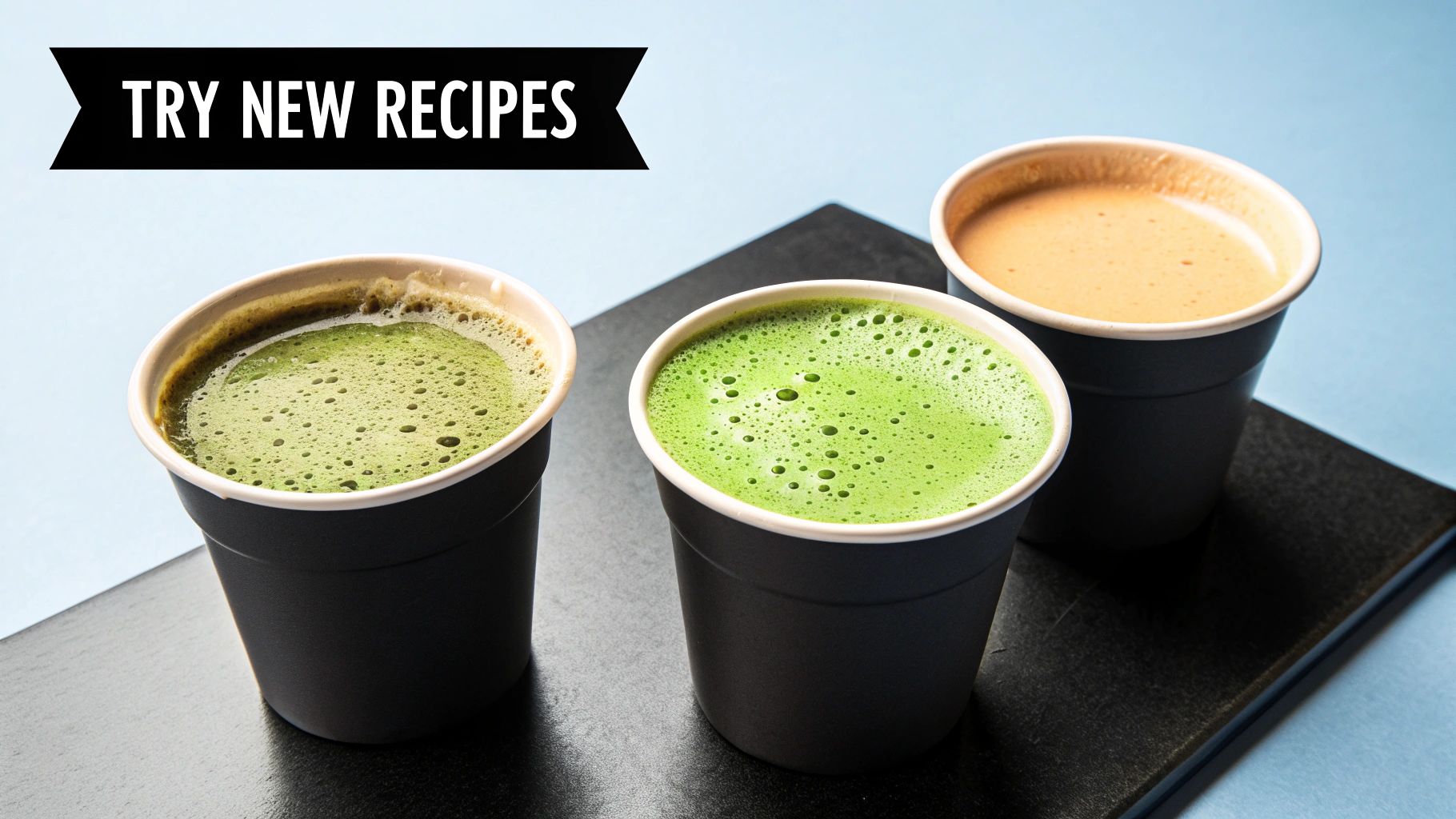
Even with the best intentions, your first few attempts at making matcha at home might not turn out perfectly. Don’t get discouraged! It’s a common experience. A lumpy texture, an unexpectedly bitter taste, or a sad lack of foam are all part of the learning curve, and thankfully, they’re all easy to fix.
Think of these little hiccups as your matcha initiation. They aren’t failures; they’re lessons that help you understand the delicate art of this incredible tea. Once you know what to look for, you'll be well on your way to a perfect bowl every time.
Why Is My Matcha Lumpy?
The number one reason for lumpy matcha is skipping the sifting step. Matcha powder is milled so finely that it loves to clump together, thanks to a bit of static and any humidity in the air. When those little clumps hit the water, the outside gets wet while the inside stays stubbornly dry, making them nearly impossible to whisk out.
The fix is simple and non-negotiable: always pass your matcha through a fine-mesh sieve before adding water. This tiny bit of prep work is your ticket to a silky-smooth, velvety drink. It’s the single most important thing you can do for texture.
Solving a Bitter Taste
If your matcha has a harsh, bitter bite, the culprit is almost always water that's too hot. Pouring boiling water—anything over 80°C (176°F)—directly onto the delicate powder essentially burns it. This releases too many catechins, which are responsible for that astringent, unpleasant flavour.
The solution is simple: patience. After your kettle boils, just let it sit for a few minutes to cool down. This one small change makes a world of difference, protecting the matcha's naturally sweet and umami notes.
Of course, the quality of your powder also plays a huge part. A lower-grade or older matcha will naturally taste more bitter. If you’re aiming for that clean, smooth flavour, using a high-quality ceremonial grade, like Amatsu's Pure Matcha, is essential.
Where Has All the Foam Gone?
That beautiful, creamy microfoam is the signature of a well-made bowl of Usucha. If yours is looking a bit flat, the issue usually comes down to your whisking technique or the tools you’re using.
Creating that froth is all about whisking air into the tea. Here’s what to check:
- Your Whisking Motion: Are you stirring in circles? Stop! You need a fast, zig-zag motion, like you’re drawing a 'W' or 'M' back and forth. Keep your wrist loose and aim for a brisk 15-20 seconds of whisking.
- The Right Tool for the Job: A traditional bamboo whisk, or chasen, is designed specifically for this. Its many flexible tines are incredibly efficient at aerating the matcha. A spoon or metal whisk just can't compete. If you don't have a chasen, an electric milk frother can be a surprisingly effective substitute.
How to Choose the Right Matcha for You
The single most important factor in how your matcha tastes at home is, without a doubt, the quality of the powder itself. Getting started with matcha can feel a bit overwhelming, especially with terms like "ceremonial" and "culinary" being thrown around. But once you understand the difference, you're on the right path to making a truly delicious bowl every single time.
Let's break it down. Ceremonial grade matcha comes from the youngest, most delicate tea leaves, picked during the very first harvest. This is the good stuff. It has a stunning, vibrant green colour, feels like silk between your fingers, and boasts a naturally sweet, umami-rich flavour with virtually no bitterness. This is what you want for drinking straight with water or making a top-notch latte.
Culinary grade matcha, on the other hand, is made from leaves harvested later in the season. It’s still a quality product, but its flavour is much stronger and a bit more astringent. This boldness is actually great for cooking, as it helps the matcha flavour shine through other ingredients in cakes, smoothies, or sauces. If you try to drink it plain, you'll likely find it bitter and a bit of a letdown.
For a deeper dive into this, have a look at our full guide on understanding different matcha tea grades.
Finding the Amatsu Blend for Your Lifestyle
Once you’ve settled on a high-quality ceremonial grade for drinking, the next step is finding a blend that fits what you’re looking for. Here at Amatsu, we’ve developed functional blends to make your daily ritual more than just a drink—it becomes a purposeful moment for your well-being.
Here’s a quick look at what we offer:
- Pure Ceremonial Matcha: This is our cornerstone, the classic blend for the purist. It delivers that smooth, rich umami flavour that's perfect for a traditional Usucha or a creamy, café-quality latte.
- Radiance Matcha: If you're looking for an inner glow, this one's for you. We’ve infused it with marine collagen to support healthy skin, hair, and nails, giving your daily cup a simple beauty boost.
- Shrooms Matcha: For those days when you need to clear the mental fog. This blend features adaptogenic mushrooms like Lion’s Mane and Cordyceps, specifically chosen to help with focus and cognitive function.
- Strength Matcha: Built for an active lifestyle, this matcha is boosted with creatine to help with muscle performance and recovery. It’s an ideal pre-workout kick-starter for clean, sustained energy.
Choosing the right matcha isn’t just about flavour. It’s about matching your daily habit to your wellness goals. Whether you’re after sharp focus, better recovery, or just a moment of peace, there’s a blend made with you in mind.
This move towards high-quality, functional teas is part of a much bigger picture. The global matcha market was valued at roughly USD 4.28 billion in 2024, and the UK is a huge part of that growth as more people embrace plant-based wellness. The trend of making matcha at home has exploded, driven by health-conscious people looking for natural superfoods that fit easily into their daily lives. You can read more by exploring the research on the global matcha market.
Your Matcha at Home Questions Answered
When you first start making matcha at home, a few questions always seem to pop up. Let's tackle some of the most common ones I hear, so you can clear up any doubts and get straight to whisking up a flawless bowl of your own.
Can I Make Good Matcha Without a Bamboo Whisk?
This is probably the number one question people ask. And the answer is yes, absolutely! While a traditional bamboo whisk, or chasen, is designed perfectly for the job and creates that signature delicate foam, you're not stuck without one.
A small electric milk frother is a brilliant, modern alternative. It’s quick, easy, and does an amazing job of getting the matcha smooth and frothy. If you’re really in a bind, you could even shake the matcha and water together in a tightly sealed jar, though the texture won’t be quite as creamy as you'd get with a frother.
Why Doesn't My Matcha Taste Like it Does at a Café?
It can be frustrating when your homemade matcha just doesn't hit the same spot as the one from your favourite local café. Usually, the difference comes down to three things: the quality of the powder, the temperature of your water, and sweetness.
Cafés almost always use a high-quality ceremonial grade matcha. They might also add a touch of sugar syrup to round out the flavour profile, making it more palatable for a wider audience. To get closer to that café taste at home:
- First, double-check you're using a ceremonial grade powder, not a culinary one meant for baking.
- Keep an eye on your water temperature. You're aiming for hot, not boiling—about 80°C is the sweet spot.
- If you prefer a sweeter drink, don't be afraid to add a little of your preferred sweetener.
The quality of your matcha powder is everything. A vibrant green, finely milled powder will always give you a smoother, sweeter result than a dull, lower-grade one.
How Should I Store My Matcha?
Finally, let's talk storage. This is so important for keeping your matcha tasting fresh and vibrant. Matcha is really sensitive to light, air, and heat, all of which can ruin its beautiful colour, flavour, and nutrients.
Always keep your powder in an airtight container, tucked away in a cool, dark place like a cupboard. If you’ve bought a tin you won’t be opening for a while, you can keep it in the fridge. Once opened, though, it’s best to use it within one to two months to enjoy it at its absolute best.
Ready to elevate your daily ritual with matcha that's perfect for you? Explore the full range of premium ceremonial blends at Amatsu Matcha and discover your new favourite way to find focus and energy. Visit our official Amatsu Matcha shop to get started.
Read more
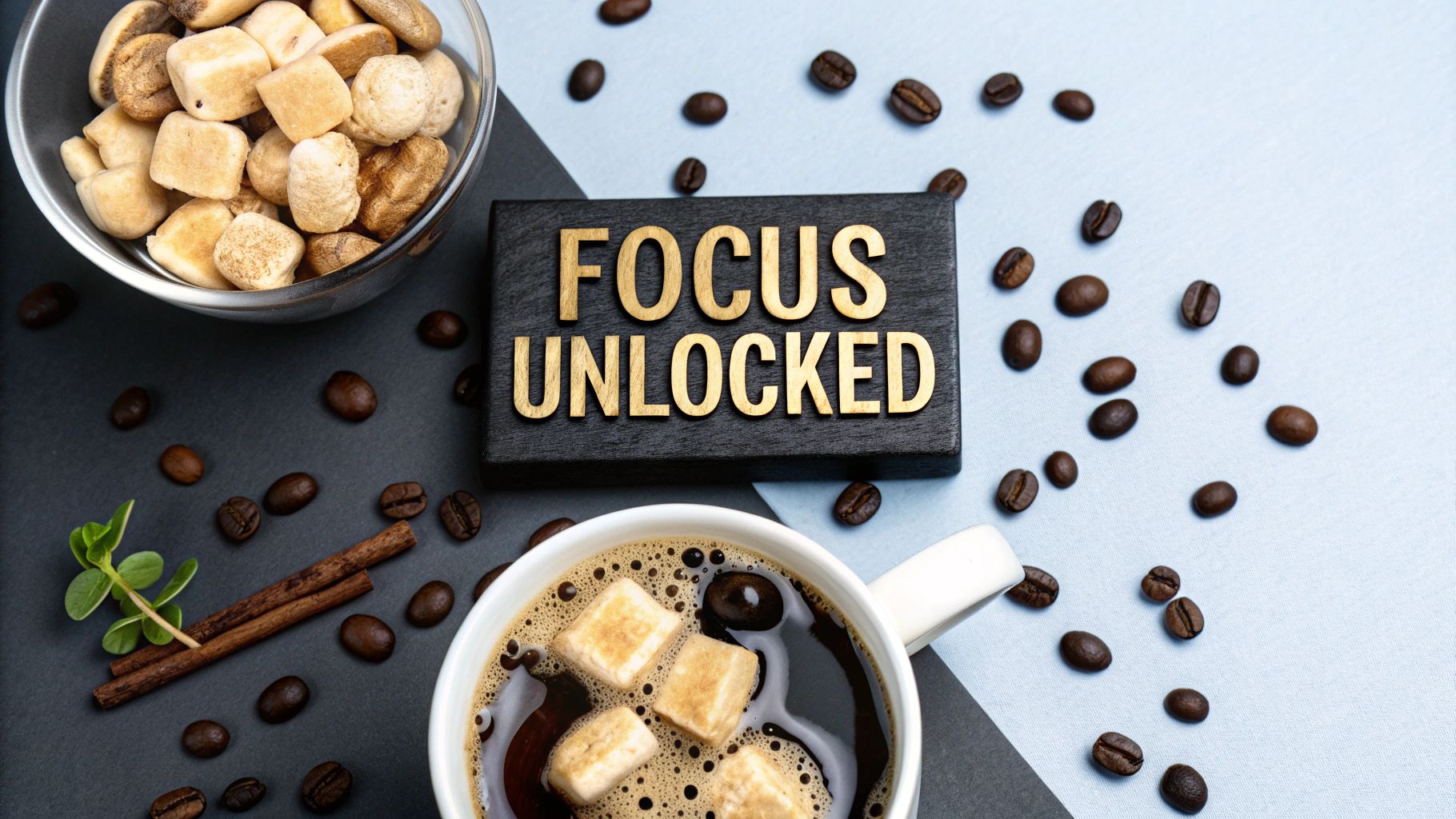
Discover how lion's mane coffee can enhance focus and mental clarity. Learn about the science, benefits, and how to choose the best brew for your brain.
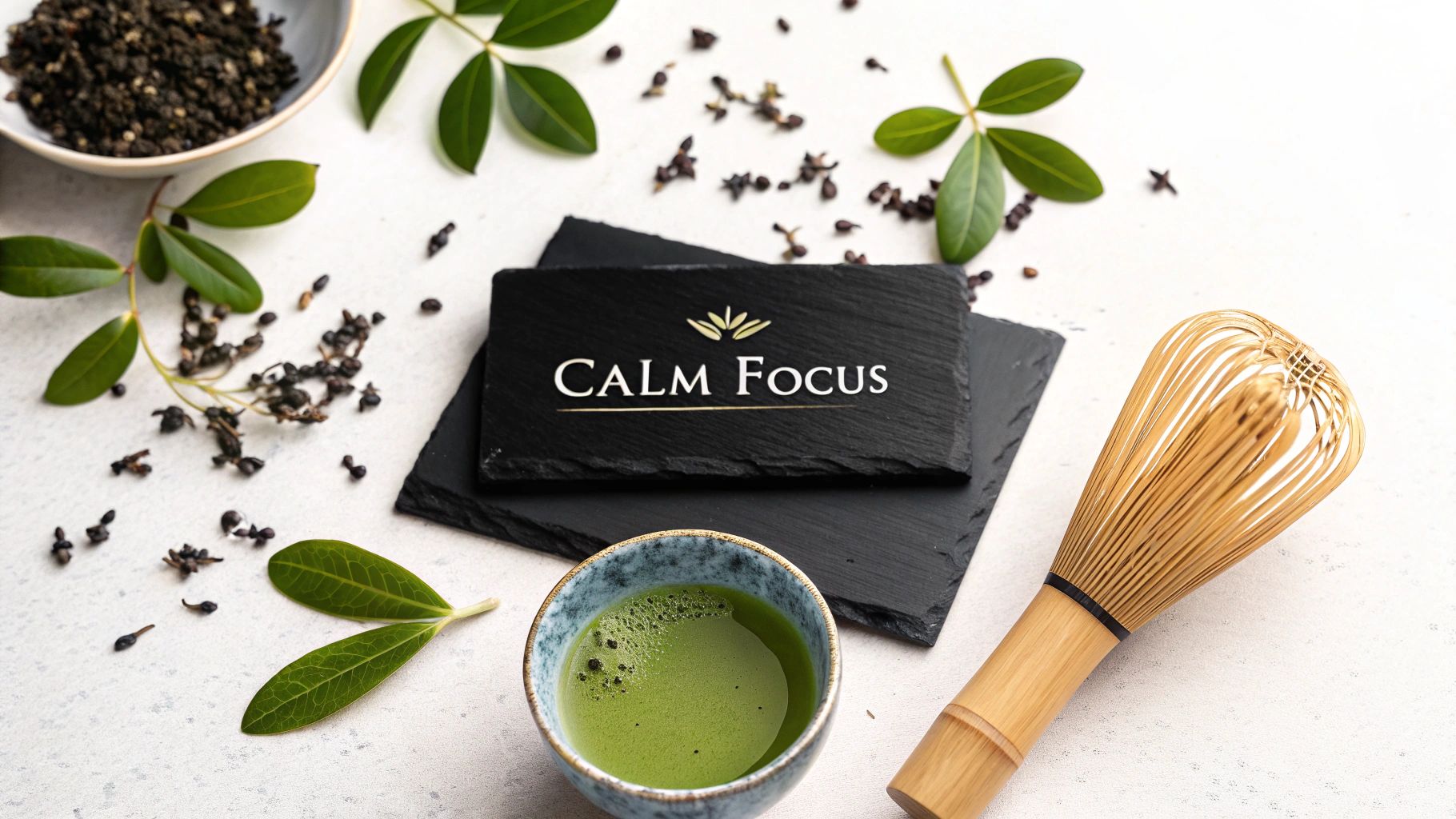
Discover how matcha l theanine creates calm focus, boosts energy, and reduces stress—safe for your skin and mood. Learn more today!
